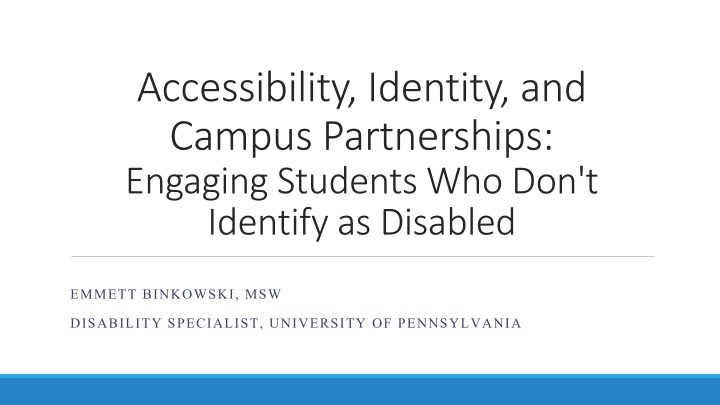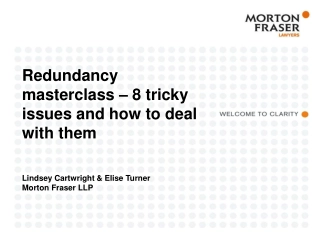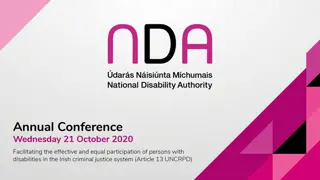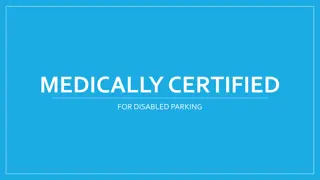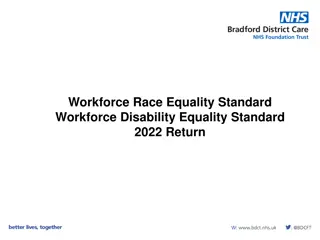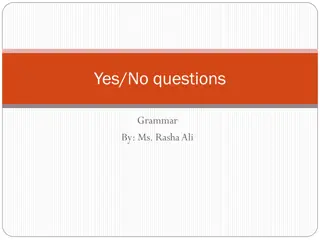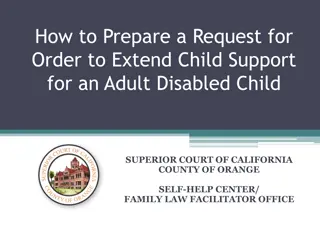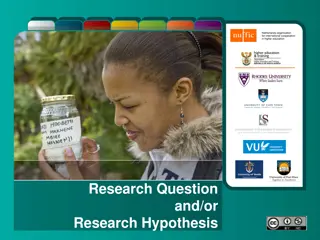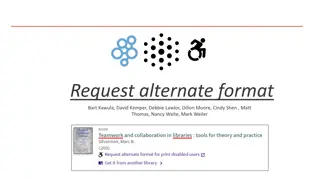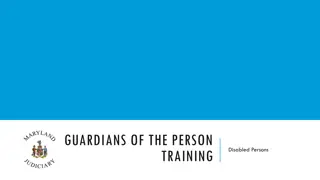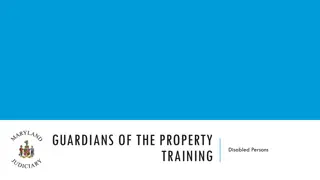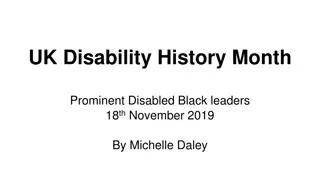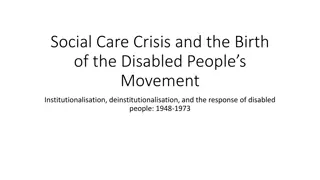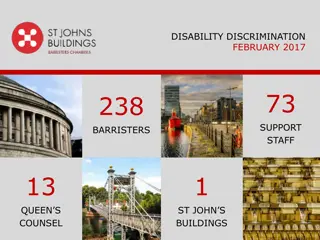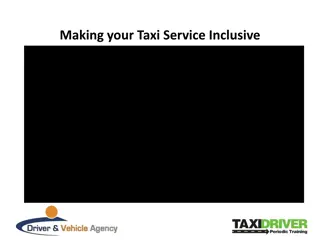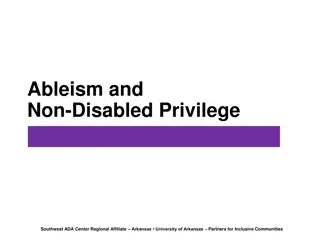Engaging Students Who Don't Identify as Disabled: Key Questions and Research Insights
Challenges faced by students who may qualify for accommodations but do not register with Disability Services, delving into how identity influences engagement with these services, and highlighting the importance of campus partnerships for enhancing student access. The content also discusses the definition of disability, prevalence rates in higher education, and qualitative research insights on why some students choose not to use accommodations.
Download Presentation

Please find below an Image/Link to download the presentation.
The content on the website is provided AS IS for your information and personal use only. It may not be sold, licensed, or shared on other websites without obtaining consent from the author.If you encounter any issues during the download, it is possible that the publisher has removed the file from their server.
You are allowed to download the files provided on this website for personal or commercial use, subject to the condition that they are used lawfully. All files are the property of their respective owners.
The content on the website is provided AS IS for your information and personal use only. It may not be sold, licensed, or shared on other websites without obtaining consent from the author.
E N D
Presentation Transcript
Accessibility, Identity, and Campus Partnerships: Engaging Students Who Don't Identify as Disabled EMMETT BINKOWSKI, MSW DISABILITY SPECIALIST, UNIVERSITY OF PENNSYLVANIA
Key Questions Are there students who might qualify for accommodations who don't register with Disability Services? How does identity impact student engagement with Disability Services? How can campus partners work together to improve student access?
Defining Disability "The term disability means, with respect to an individual (A) a physical or mental impairment that substantially limits one or more major life activities of such individual; (B) a record of such an impairment; or (C) being regarded as having such an impairment" (Americans with Disabilities Act, 1990, As Amended)
Research - Prevalence How many students in higher ed have a disability? 19% of undergraduates reported a disability in the 2015-16 academic year, up from 11% in 2008 (NCES, 2018; Madaus & Kunkes, 2023) Among students who ever had a reported disability since 9th grade: 37% told their college about their disability in 2016 (Adam & Warner-Griffin, National Center for Education Statistics, 2022) Identification may change over time Aquino and Bittinger (2019) found that 59% of students who self-identified as having a disability in their first year no longer identified two years later.
Research: Qualitative Experiences of Students Laura Murray (2017): Why do some students choose not to use accommodations? Top reason: I don t need them I don t identify as disabled was the second-most common reason Some students didn t realize that their diagnosis would count as a disability Belief that Disability Services is only for physical disabilities Some students thought registering for accommodations would reflect badly on them with instructors "Fear of being perceived as somehow exploiting the system for personal gain
Research: Qualitative Experiences of Students Making Meaning: O'Shea & Meyer (2016) Students with nonvisible disabilities may construct their disability as part of their self-identity; they may see it as a "minor irritation" to overcome; or they might reject the label "disabled" completely Students who integrated their disability into their identity may be more likely to disclose it
Research: Stigma Parsons et al (2023), Ontario: Students reported overwhelmingly positive interactions with faculty, but every student had at least one negative experience Instructors who implied a student was "faking" their disability Forgetting to implement accommodations (such as sending exams to the testing center on time) Discussing accommodations in front of other students
Research: Stigma Grimes et al. (2020), Australia: 28% of students who chose not to disclose their disability mentioned stigma as a contributing factor Negative comments from teachers, admin staff, parents, and peers Students anticipated negative reactions to disclosure, both at university and future workplaces Internalized stigma leaves students feeling ashamed, believing they are less academically capable than peers Stigma decreases the chances that students will ask for help from instructors and peers (even when students recognized that they needed support)
Research - Outcomes Is non-identification a problem? Chiu et al. (2019) found that GPA trajectory improved after registering with Disability Services, but racial disparities persisted Self-advocacy skills are associated with higher GPA in students with disabilities (Fleming et al. 2017) Schechter (2018) found that students who registered with Disability Services in their first year were more confident that they would graduate, compared to those who registered later Students with a disability request academic supports at a higher rate and use more academic services than non-disabled students (such as writing centers and tutoring programs) (NCES)
The Impact of COVID-19 Potential increases in the number of disabled students Long COVID and other chronic health conditions Mental health conditions: Students surveyed in 2020 reported significantly higher stress, anxiety, and depression than in 2016 (Roche et al., 2022) Increased attention to accessibility (especially re: remote learning) "Accidental" universal design (Behling et al., 2021)
Research Recent trends in Disability Services: Kunkes & Warren (2023) Shift in focus: access is not solely for legal compliance, but a moral obligation to promote equity and inclusion Requires less emphasis on the medical model of disability Aspirational (social justice as the goal)
Scenario 1 Alex, an Engineering major in their junior year, visits your office during drop-in hours to ask about tutoring resources. Then they mention: "I could really use help with keeping track of everything. I have ADHD, but my parents didn't want me to go on medication, so nothing ever happened."
Scenario 2 You meet with a graduate student named Max. He was a student-athlete as an undergraduate. His academic advisor referred him to Disability Services because he's having trouble finishing exams. When you bring up extended time, Max says: "I really do need more time to finish all the questions, but if I take my exams at the testing center then my friends will notice I'm not in the classroom. I don't want them to know that I have accommodations. They know about my concussions, but they think I should just push through it."
Key Takeaways Engaging with students: Educating students about their rights and responsibilities Building self-advocacy skills Emphasizing the importance of consent and confidentiality Recognizing that identity and disability status can be fluid
Key Takeaways Campus-wide efforts: Encouraging referrals while decreasing stigma Focusing on social justice and access, not just legal compliance Including disability in DEIB efforts on campus
Q&A EMAIL ME! EBINK@UPENN.EDU
References Aquino & Bittinger (2019). The Self (un)Identification of Disability in Higher Education. Journal of Postsecondary Education and Disability, 32(1), 5-19. Behling, K., Pillette, K., & Bibeau, L. (2021). Accidental UDL: A silver lining of the COVID pandemic. Thriving in Academe, 39(3). www.nea.org/sites/de- fault/files/2021-10/Thriving%20Sept%202021.pdf Chiu, Y. J., Chang, H. V., Johnston, A., Nascimento, M., Herbert, J. T., & Niu, X. M. (2019). Impact of Disability Services on Academic Achievement Among College Students with Disabilities. Journal of Postsecondary Education and Disability, 32(3), 227 245. Fleming, A. R., Plotner, A. J., & Oertle, K. M. (2017). College Students with Disabilities : The Relationship Between Student Characteristics , the Academic Environment , and Performance. Journal of Postsecondary Education and Disability, 30(3), 209 221. Grimes, S., Southgate, E., Scevak, J., & Buchanan, R. (2020). University Student Experiences of Disability and the Influence of Stigma on Institutional Non-Disclosure and Learning. Journal of Postsecondary Education and Disability, 33(1), 23 37. Kunkes, I. B., & Warren, C. (2023). Moving from Compliance to Social Justice and Access : Applying AHEAD s Revised Code of Ethics , Professional Competencies , and Program Standards. Journal of Postsecondary Education and Disability, 36(4), 387 392.
References Madaus, Joseph W.; Kunkes, I. B. (2023). The (Modern) History of Disability Services in higher education. Journal of Postsecondary Education and Disability, 36(4), 319 329. National Center for Education Statistics (2018). Digest of education statistics, 2017 (205-016). U.S. Department of Education. O Shea, A., & Meyer, R. H. (2016). A Qualitative Investigation of the Motivation of College Students with Nonvisible Disabilities to Utilize Disability Services. Journal of Postsecondary Education and Disability, 29(1), 5 23. Parsons, J. M., Mccoll, M. A., Martin, A., & Reynard, D. (2023). Transition and Accommodation Experiences of Students with Disabilities : A Qualitative Study. Journal of Postsecondary Education and Disability, 36(2), 179 192. Roche, A. I., Holdefer, P. J., & Thomas, E. B. K., (2022). College student mental health: Under- standing changes in psychological symptoms in the context of the COVID-19 pandemic in the United States. Curr Psychol. https://doi. org/10.1007/s12144-022-03193-w Schechter, J. (2018). University Students with Disabilities: Factors that Contribute to Their Self-Predicted Likelihood of Graduation. Journal of Postsecondary Education and Disability, 31(4), 335 346.
References Snyder, T.D., de Brey, C., and Dillow, S.A. (2019). Digest of Education Statistics 2017 (NCES 2018-070). National Center for Education Statistics, Institute of Education Sciences, U.S. Department of Education.
